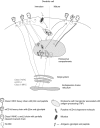Endosomal processing for antigen presentation mediated by CD1 and Class I major histocompatibility complex: roads to display or destruction
- PMID: 19476512
- PMCID: PMC2691781
- DOI: 10.1111/j.1365-2567.2009.03078.x
Endosomal processing for antigen presentation mediated by CD1 and Class I major histocompatibility complex: roads to display or destruction
Abstract
The presentation of antigen in a form that can be recognized by T lymphocytes of the immune system requires antigen processing and association of antigen-derived fragments with molecules encoded by the major histocompatibility complex (MHC) locus or by the CD1 locus. Much emphasis on antigen processing and presentation in the last decades has focused on what we consider 'conventional routes' of antigen processing and presentation, whereby extracellular antigens are processed for presentation via Class II MHC complexes and cytosolic antigens are presented as peptide-Class I MHC complexes. We here highlight two other pathways in myeloid dendritic cells, those of lipid antigen presentation in association with CD1 and of peptide cross-presentation via Class I MHC complexes. Some pathogens evade immune recognition through inhibition of antigen presentation of phagosomal origin. Deviations in endosomal antigen processing and presentation are also seen in individuals suffering from glycosphingolipid lysosomal lipid storage diseases. We summarize recent developments in the endosomal antigen processing and presentation pathway, for display as lipid-CD1 complexes to natural killer T cells and as peptide-Class I MHC complexes to CD8 T cells.
Figures

Similar articles
-
The Third Way: Progress on pathways of antigen processing and presentation by CD1.Immunol Cell Biol. 2004 Jun;82(3):295-306. doi: 10.1111/j.0818-9641.2004.01258.x. Immunol Cell Biol. 2004. PMID: 15186261 Review.
-
Activation of human CD4+ T cells by targeting MHC class II epitopes to endosomal compartments using human CD1 tail sequences.Immunology. 2007 Dec;122(4):522-31. doi: 10.1111/j.1365-2567.2007.02666.x. Epub 2007 Jul 16. Immunology. 2007. PMID: 17635609 Free PMC article.
-
Regulation of MHC II and CD1 antigen presentation: from ubiquity to security.J Leukoc Biol. 2009 Feb;85(2):215-24. doi: 10.1189/jlb.0308206. Epub 2008 Sep 22. J Leukoc Biol. 2009. PMID: 18809734 Review.
-
The exogenous pathway for antigen presentation on major histocompatibility complex class II and CD1 molecules.Nat Immunol. 2004 Jul;5(7):685-92. doi: 10.1038/ni1088. Nat Immunol. 2004. PMID: 15224094 Review.
-
Antigen presentation by CD1 and MHC-encoded class I-like molecules.Curr Opin Immunol. 1996 Feb;8(1):82-8. doi: 10.1016/s0952-7915(96)80109-9. Curr Opin Immunol. 1996. PMID: 8729450 Review.
Cited by
-
Hiding lipid presentation: viral interference with CD1d-restricted invariant natural killer T (iNKT) cell activation.Viruses. 2012 Oct 23;4(10):2379-99. doi: 10.3390/v4102379. Viruses. 2012. PMID: 23202469 Free PMC article. Review.
-
Critical role for invariant chain in CD1d-mediated selection and maturation of Vα14-invariant NKT cells.Immunol Lett. 2011 Sep 30;139(1-2):33-41. doi: 10.1016/j.imlet.2011.04.012. Epub 2011 May 5. Immunol Lett. 2011. PMID: 21565221 Free PMC article.
-
Diet-induced dyslipidemia enhances IFN-γ production in mycolic acid-specific T cells and affects mycobacterial control.Mucosal Immunol. 2025 Aug;18(4):899-910. doi: 10.1016/j.mucimm.2025.04.009. Epub 2025 May 3. Mucosal Immunol. 2025. PMID: 40324594 Free PMC article.
-
Invariant natural killer T cells in adipose tissue: novel regulators of immune-mediated metabolic disease.Cell Mol Life Sci. 2013 Dec;70(24):4711-27. doi: 10.1007/s00018-013-1414-1. Epub 2013 Jul 9. Cell Mol Life Sci. 2013. PMID: 23835837 Free PMC article. Review.
-
Cross-talk between cd1d-restricted nkt cells and γδ cells in t regulatory cell response.Virol J. 2011 Jan 21;8:32. doi: 10.1186/1743-422X-8-32. Virol J. 2011. PMID: 21255407 Free PMC article. Review.
References
-
- Ueno H, Klechevsky E, Morita R, et al. Dendritic cell subsets in health and disease. Immunol Rev. 2007;219:118–42. - PubMed
-
- Picker LJ, Siegelman MH. in Paul W.E. Fundamental Immunology. 3rd edn. Philadelphia, PA: Lippinscott Williams & Wilkins; 1993.
-
- Burgdorf S, Scholz C, Kautz A, Tampe R, Kurts C. Spatial and mechanistic separation of cross-presentation and endogenous antigen presentation. Nat Immun. 2008;9:558–66. - PubMed
Publication types
MeSH terms
Substances
Grants and funding
LinkOut - more resources
Full Text Sources
Other Literature Sources
Research Materials

